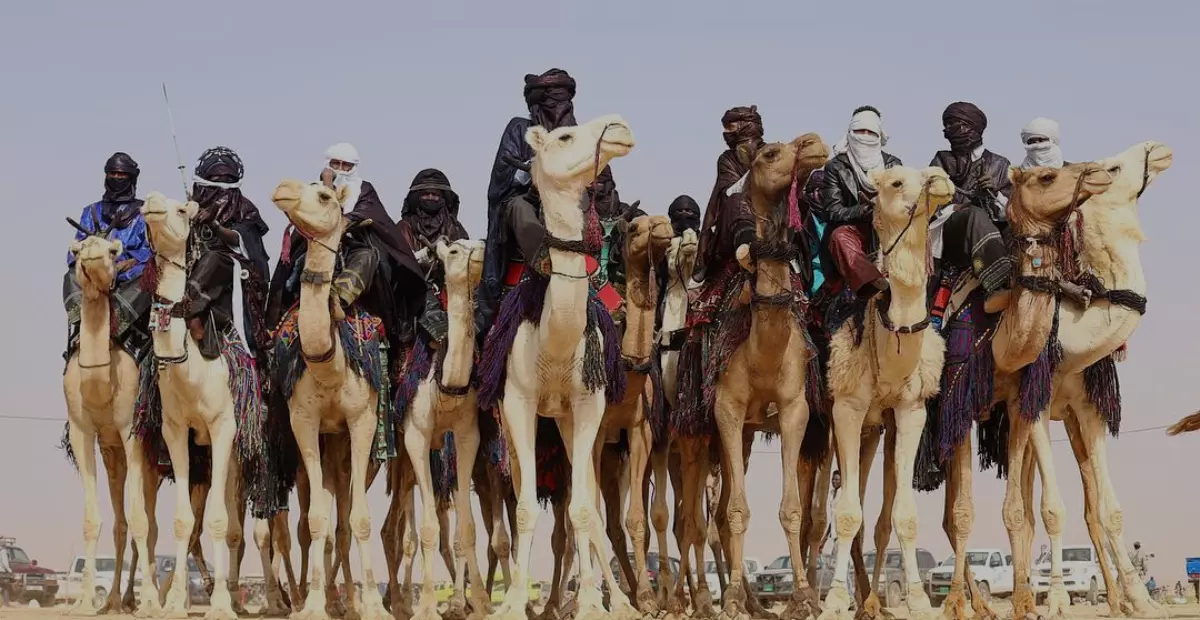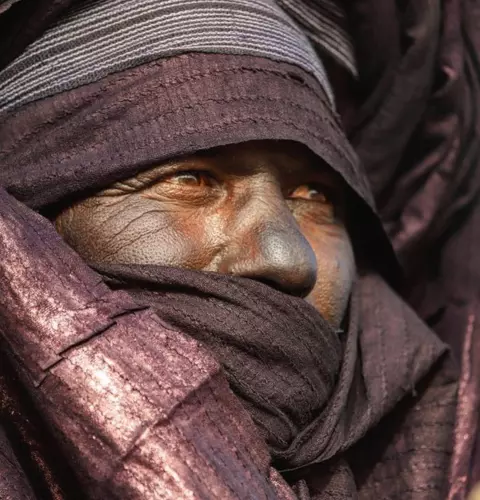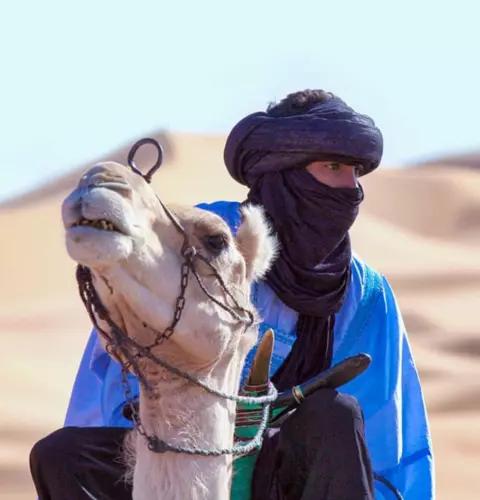
Blog
The Tuareg: Learn About The Legendary Blue Men of the Desert
Discover the fascinating culture of the Tuareg people. Learn about their history, traditions, iconic indigo clothing, and nomadic way of life in the Sahara.
Introduction
Silhouetted against Morocco’s southern Saharan horizon are the distinctive forms of the Tuareg – the legendary “Blue Men” of the desert. As the winds sculpt ethereal sand dunes, the Touareg remain icons of resilience and ingenuity amid one of the harshest environments on earth. Their vibrant indigo robes stand out against amber sand seas, symbolizing bonds to tradition and one another. While behind their embroidered veils lies a proud people whose rich culture spans borders and over two millennia of caravan trading, pastoralism, and poetry.
Yet beyond romantic legends, the Tuareg way of life has changed much in modern times. Today most are settled in towns and oases rather than living fully nomadic existences. Still, the Tuareg spirit endures – steeped in the lore of the vast desert humanity has called home for centuries. From their unique Tifinagh script to melodies sung in the Tamachek language, the Tuareg safeguard an integral facet of North Africa’s cultural heritage and history. Join us to discover the captivating traditions, Adornments, and life of Morocco’s famed desert dwellers – the mystical Tuareg.
Origins and Shared Identity
The Tuareg constitute a distinct indigenous Berber ethnic group:
- Historically inhabiting the central Sahara spanning present-day Libya to Mali.
- Shared cultural aspects like language, poetry, music connect Tuareg communities separated by borders.
- The otamads are the highest caste of nobles, followed by smiths, religious leaders, and vassals.
- Society is highly hierarchical and patriarchal. Tribes vary between more open or rigid statuses.
- Converted to Islam in the 11th century but retain some animist beliefs.
Despite being dispersed across nations, Tuareg’s identity endures through common pillars of language, appearance, and heritage.
Traditional Livelihoods and Society
Tuareg groups were historically:
- Nomadic pastoralists grazing camels, goats, and sheep across the desert.
- Crucial traders in the trans-Saharan caravan routes network.
- Semi-nomadic, migrating seasonally while maintaining homes in oasis towns.
- Camps consisted of mobile tents and temporary shelters.
- Men traveled for trade and herding animals, women maintained the home.
- Socially divided between higher caste nobles and vassal tribes.
Their self-sufficient society flourished within the harsh Saharan terrain.
Famous Indigo Clothing
Tuareg attire is iconic thanks to vivid dyeing:
- Dark indigo turbans and robes signify noble status and protect from the desert.
- Women’s cloth face veils, vibrant dresses, and ornate jewelry.
- Clothing embroidered with distinct tribal patterns and motifs.
- Textiles dyed using pigments from the indigo plant.
- Intricate leatherwork on bags, saddles, tent decorations.
- Clothing conveys identity and keeps traditions alive.
The distinctive “blue men” appearance withstands the desert and time.
Culture and Language
Tuareg society retains artistic traditions:
- Tamachek is the unifying Tuareg Berber language with Tifinagh writing.
- Iggawen poets improvise verse on themes like love, nature, and heroes.
- Tende percussion, imzad fiddle, and tahardent lutes comprise Tuareg instruments.
- Intricate silver jewelry denotes female family status.
- Cure salée salt cure celebrations affirm bonds and identity.
- Blending of Islam with matriarchal Tuareg beliefs.
From poetry to music, Tuareg heritage remains vibrant in community life.
Tuareg in Modern Morocco
Lifestyles have shifted but identity persists:
- Many Tuareg now settled in Saharan towns and oases like Zagora, Tagounite.
- Tourism services and government roles provide livelihoods vs nomadism.
- Some friction over resources and autonomy from the central Moroccan government.
- Youth maintain cultural heritage through language lessons and festivals.
- Small minorities still lead fully nomadic lives in the desert interior.
While settlement alters traditions, the Tuareg spirit adapts and carries on.
Conclusion
Against the endless Sahara, the blue-robed forms of the Tuareg invoke the lasting power of culture and human spirit. As the caravan era faded, their nomadic routes may have shifted to settled existences in towns. Yet the soul of the Tuareg remains – testament to the combined might of community, lore, language, and land that nourished their society for eons. By preserving the poetry, indigo swathes, and timeless rituals that defy desert storms, the Tuareg safeguard invaluable heritage for future generations.
Morocco is proud to harbor these desert dwellers and their enduring identity that transcends the isolation of vast sands. As Tuareg songs echo against rock walls, we’re reminded that the inhospitable can nurture rich legacies when people bond deeply to the elements that surround them. The desert winds scatter and rebirth, but human heritage persists – just as the Tuareg people have conquered all that nature and time have lain before them thus far.
Get Inspired and Plan Your Trip Today!
- Check out our Morocco Private Tours to see all the fantastic places you can visit in Morocco.
- Customize your own tour using the form on our website to create a vacation that is perfect for you.



FAQs
The Tuareg are an indigenous Berber ethnic group concentrated in the Saharan interior of North Africa, including parts of Morocco’s deep south.
The indigo blue turbans and robes worn by Tuareg men give them the nickname “Blue Men of the Desert”. The dye protects against the sun.
Tuareg society is organized into nobles, religious leaders, craftsmen, and vassal tribes. They were historically nomadic pastoralists and desert traders.
Most Tuareg today are settled in Saharan oasis towns like Zagora and Tagounite. Smaller numbers retain a nomadic lifestyle in the desert interior.
Visiting Zagora and southern oases, attending festivals, riding camels in the dunes, and shopping for artisan crafts and jewelry offer insight into Tuareg traditions.
Arhhal
Moroccan Travel Expert
Plan an Entertaining Moroccan Holiday Now!
We can help you fit your stay and experience within your allotted budget.
